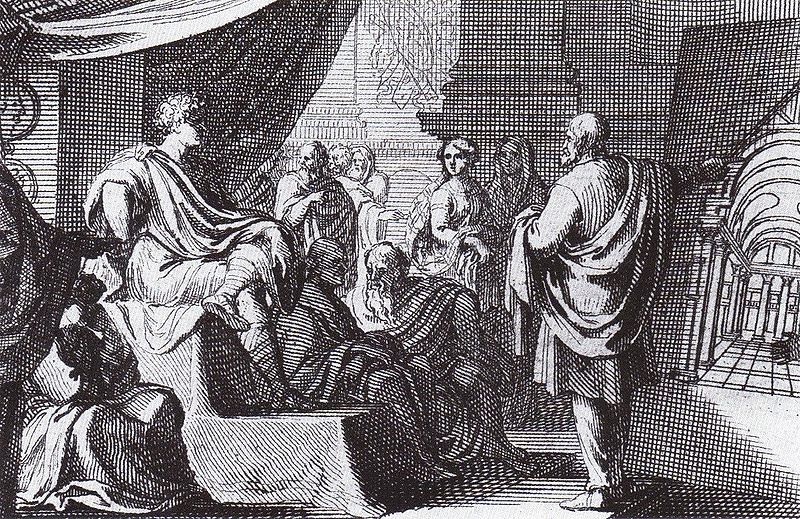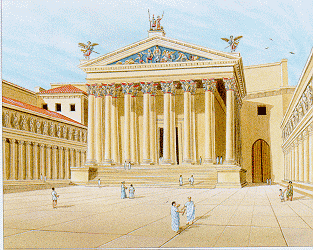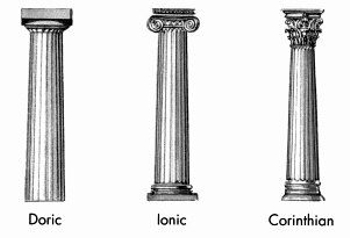




Little is known about Vitruvius' life, but he was likely born a free Roman citizen, and served the Roman army under Julius Caesar. He specialized in the construction of ballista and artillery war machines as his first ventures into the field of architecture. His service likely included North Africa, Hispania, Gaul, and Pontus, but we cannot be sure as although he does describe such places throughout his works, De Architectura, he does not say whether he himself was present or not. These works are known today as The Ten Books on Architecture. In the preface of Book I, Vitruvius dedicated his writings to give personal knowledge of the quality of buildings to the emperor, and this book is the only surviving major architecture book from classic antiquity, making it extremely valuable. Vitruvius is actually referring to Marcus Agrippa's campaign of public repairs and improvements throughout this book. This book is most famous for Vitruvius’ assertions if the three qualities that a structure must possess, being ITAL: furmitas, utilitas, and venustas. In other words, each structure must be strong or durable, useful, and finally beautiful. He stated that architecture was an imitation of nature, just as birds and bees build their nests, humans construct our housing of natural materials to provide shelter against the elements. He went on to say that the Ancient Greek perfected this art of building by inventing the architectural orders of Doric, Ionic, and Corinthian. These orders provided a sense of proportions of the human body, which was considered to be the greatest work of art. This led to the defining of the Virtuvian Man, later drawn by Leonardo da Vinci. This human body, pictured left, is inscribed in the circle and the square, which are important because they are the fundamental geometric patterns of the cosmic order.
 ises on using a bronze disc set into the roof under a circular structure to control the heat in the hot rooms, which could be raised or lowered by a pulley to adjust ventilation. It is likely that his dewatering devices, such as the reverse overshot water-wheel, were used in the larger baths to lift water to header tanks, such as the Baths of Diocletian and the Baths of Caracalla.
ises on using a bronze disc set into the roof under a circular structure to control the heat in the hot rooms, which could be raised or lowered by a pulley to adjust ventilation. It is likely that his dewatering devices, such as the reverse overshot water-wheel, were used in the larger baths to lift water to header tanks, such as the Baths of Diocletian and the Baths of Caracalla.The surviving ruins of Roman antiquity, along with the Roman forum and temples, as well as theatres, with triumphal arches and their reliefs, and statues, all giving sufficient visual examples of the descriptions in the texts of Vitruvius. This book quickly became a major inspiration for Renaissance, Baroque (and as I like to say, if it's not Baroque, don't fix it!), and Neoclassical Architecture. The famous Brunelleschi, for example, invented a new type of hoist to lift the large stones for the dome of the cathedral in Florence, prompted by De Architectura as well as viewing the many surviving Roman monuments like the Pantheon and the Baths of Diocletian in Rome, which all showed evidence of Vitruvian work. So, it is very evident the Vitruvius’ contributions to architecture were of vital importance to his time and to the future of architecture.




Very little background information is known about Lucius Cocceius Auctus, but he was chosen by Agrippa (August Caesar's stategist and successor) to build many famous structures.
Auctus's most dignified accomplishment is the excavation and construction of the Crypta Neopolitana (pictured to the right), a tunnel which led west from what is known today as Naples to Pozzuoli. It is over 700 meters in length. Auctus directed this project during the civil war of August Caesar and Sextus Pompeius in 37 BC. It was formerly rumored that Virgil built it in a single night, but it has since been proven that Auctus was responsible for this useful passage. Other notable features of this tunnel include what is called Virgil's tomb, and the burial site of the Italian poet Giacomo Leopardi. It still stands today, but it has been modified several times by the Bourbon dynasty of Naples in the late 19th century. It is currently being preserved as an archaeological site.
In addition, he converted the Capitolium in Pozzuoli into a Temple of Augustus. The Capitolium, or the Capitoline Hill, is one of the seven hills of Rome. The English word capitol derives from this hill. Few ancient ruins remain on it, because these were built over during Medieval times. However, it is important that Auctus built a Temple of Augustus at this location. Augustus Caesar, or Octavian, was Caesar's successor and this temple may have been one of the first to honor him.
The Pantheon of Rome is one of the greatest Roman landmarks. The word Pantheon means all gods and it honored 12 Roman gods when it was first built. In 27 BC, it is said that Marcus Agrippa built the Pantheon. This is made evident by the following engraving:
|
(Latin) Marcus Agrippa, Lucii filius, consul tertium fecit. Marcus Agrippa, son of Lucius, Consul for the third time, built this.
|

However, Auctus was chosen by Agrippa to complete many construction projects. Therefore, it is believed that Auctus is actually the designer of the original Pantheon. An artist's depiction of what this original building might have looked like is shown to the left. Unfortunately, fire destroyed it in the year 80 AD. It was rebuilt in 126 AD, when the Emperor Hadrian reigned. Although it was rebuilt, Hadrian added a new engraving which was identical to the original that Agrippa added. To this day, Agrippa receives the credit to the building of the Pantheon. It would be more accurate to say that Auctus built it, for he was the original designer of the Pantheon and the chosen construction worker for Agrippa. It is unfortunate that Hadrian does not usually receive credit, even though he constructed the current Pantheon that still stands today. No matter who gets congratulated for building this amazing monument, it is without a doubt that all of these men have contributed to a lasting part of Roman culture.



The Colosseum was first known as the Flavian Ampitheatre, due to the fact that its builders, Vespasian and Titus, were both emeperors of the Flavian family. In 70 AD, construction began in a valley formed by the Esquiline, Caelian, and Palatine hills. These hills originally formed the pond of Nero's Domus Aureus. The name "Colosseum was most likely coined due to the enormous statue of Nero that once stood near it. This construction was finally finished around 80 AD , with seats that held almost 60,000 audience members. Many hundreds of gladiators and animals were slaughtered to celebrate its opening. The Colosseum was filled with water on some occasion, in order to replicate fights at sea. However, this usually took place in large basins, which were made solely for that purpose. The Colosseum even had a separate entrance for the emperor, and even a private box seat. He decided on the fate of the gladiators from there. A layer of sand was used to cover the floor of the Colosseum, which covered a maze of passageways and pens for holding animals. A manual elevator facilitated the process of raising animals to the arena from the basement. Although the Italian government refloored the Colosseum, the walls of these underground tunnels are still visible today.
The Colosseum is renown for its beauty, but also its efficiency. Estimates show that 50,000 spectators can enter and find seats in just a quarter of an hour. This is because Romans invented tickets and assigned seating. Each person was assigned an arch (1-79; #80 was reserved for the emperor), as well as a row and seat number. Some senators carved their names into the seats to save them, and these carvings can still be seen today. The structure and ticket system of Colosseum have lasted up until the present, where they are used in events such as baseball and bull-fighting. This building is obviously still standing today, but it has suffered neglect, earthquakes, and some parts have been stolen by others to be used for different buildings.

The oval shape of the Colosseum sits on its axis in a northeastern direction. Brick and a soft rock known as tufa are the material that construct the core, while the outside is a travertine marble. This marble is brilliantly white stone that was favored by Michelangelo in his most famous sculptures. At first, the Colosseum was three stories high, until a fourth was added by Alexander Severus when the building was added to around 230 AD. An archetrave is a horizontal band running around the entire Colosseum, and separated the three stories. These three stories had 80 arches each, and every arch lines up exactly with the one above it and below it. The 80 entrance arches on the bottom story are each separated Doric columns, which are impossible to walk behind because they are engaged, meaning that the column shafts are actually part of the wall. The second story, on the contrary, has engaged Ionic columns, and the third has Corinthian. The fourth story is simply a solid wall with thin Corinthian pilasters, which are rectangular columns.

A comparison of the three types of columns.
40 small, rectangular windows and 40 bucklers were used to fill the space between the pilasters, however the bucklers have been lost over the years. This combination of airy arches containing thin archetraves with strong support columns help the Colosseum to look sturdy, while at the same time open and soaring. The oldest type of column, the Doric column, is strong and severe in appearance, allowing the first story to appear to be a strong foundation. As your eyes move up the building, you notice the columns slowly become more recent and more refined, assisting the lightness of the upper stories. A lack of a roof did not help to keep the sun from affecting both the spectators and performers from the treacherous sun in the summer months. So, great canvas sheets were rigged to the top, forming awnings during this time of year. Sailors were needed from the nearby port of Ostia to manage these sails, because they were so large and cumbersome. With such awnings attached, the magnificent Colosseum was said to have looked something like a grand barge that could simply sail away in its elegance.




The magnificent landmarks of Rome, some still standing today, all have a history behind them. The great men who built these incredible sculptures have certainly contributed to Italian culture and have created sights for people to see all around the world. In addition, people like Vitruvius established the principles of architecture, as well as forming many inventions and ideas that are still used in the twenty-first century. It is remarkable that traces of ancient Roman architects can be found in our buildings today. As we step further and further into the modern age, it is important to remember where it all started from, even if it was around the time of the famous Julius Caesar.


|
"Colosseum (Colosseo)." A View on Cities. 2009. 22 Apr 2009
<http://www.aviewoncities.com/rome/colosseo.htm>.
Matthews, Kevin. "Roman Colosseum." Great Buildings Online. 1994-2008. Artifice, Inc.. 4
May 2009 <http://www.greatbuildings.com/buildings/Roman_Colosseum.html>.
"Pozzuoli." CampiFlegrei. 2 May 2009 <http://www.icampiflegrei.i
/visita_pozzuoli_ing.htm>.
Thayer, Bill. "Vitruvius on Architecture." LacusCurtius. 24 Jan 2006. 30 Apr 2009
<http://penelope.uchicago.edu/Thayer/E/Roman/Texts/Vitruvius/home.html>.
"Vitruvius." Encyclopædia Britannica. 2009. Encyclopædia Britannica Online. 04 May. 2009
<http://www.britannica.com/EBchecked/topic/631310/Vitruvius>.
|
| NOTE: This wiki may not work properly with low screen resolutions (the pictures will not line up correctly). Thanks for understanding! |